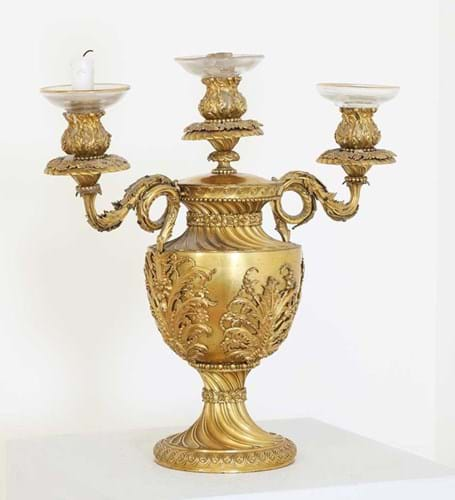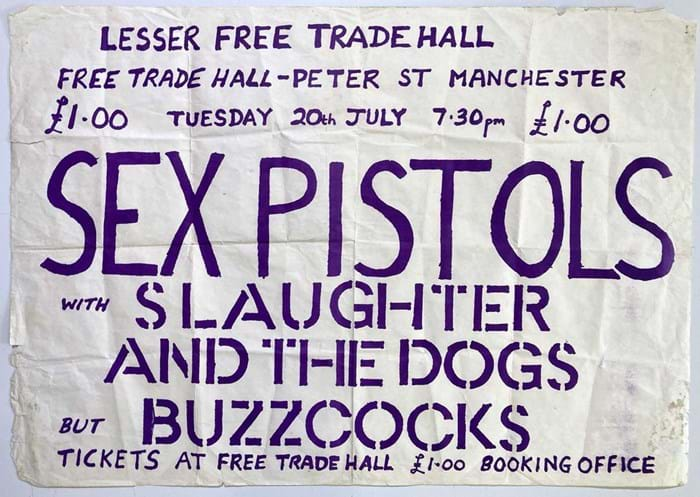1. Anti-slavery glass rummer – £5000
The medallion of a kneeling slave asking the rhetorical question ‘Am I Not A Man And A Brother’ was first made in 1787 upon the founding of the Committee for the Abolition of the Slave Trade.
It is thought to have been commissioned by committee member Josiah Wedgwood, modelled by the sculptor Henry Webber and prepared for production in black on white jasperware by William Hackwood.
The motif ultimately became the emblem for the British anti-slavery movement and many versions of the kneeling slave found their way onto objects made in ceramic, metal, glass and fabric. Some pre-date the 1807 Abolition of the Slave Trade Act that made it illegal to engage in the slave trade throughout the British colonies but, as the practice of slavery itself continued in the West Indies until 1833, it was necessary to keep the campaign alive well into the 19th century.
Antislavery objects are enjoying a particular strong ‘moment’ in the marketplace as museums and other institutions seek to acquire items relating to the slave trade and the experience of enslaved African Americans in particular.
This engraved English glass rummer c.1800, offered as part of the sale of Ceramics and Glass at Woolley & Wallis in Salisbury on April 26, is particularly rare. Most survivors are ceramics. It is engraved to one side with 'Am I Not a Man and Brother' and to the reverse with a verse 'Health to the Sick, Honour to the Brave, Success to the Lover and Freedom to the Slave’.
It was modestly estimated at £150-250 but was avidly competed to £5000.
2. Ormolu candelabrum – £11,000

Ormolu candelabrum designed by James ‘Athenian’ Stuart and made by Diederich Andersen – £11,000 at Sworders.
This 13in (33cm) ormolu vase candelabrum is a candidate for the earliest English neoclassical metalwork. The 33cm high gilt bronze is part of a series designed by the architect James ‘Athenian’ Stuart and made by the London metalworker Diederich Andersen around 1760, several years before the classical revival became the peak of Georgian fashion.
Matthew Boulton is known to have purchased items from Andersen's stock following his death in 1767, elements of which he copied for his own candelabra vases made in the 1770s.
Other examples of this Stuart-Andersen design form part of the collections of Her Majesty the Queen and the Victoria and Albert Museum. In 2010, as part of Christie’s sale of items from the Spencer House, the London town house of the Spencer family until 1924, a pair of three-light candelabra dated 1758-65, sold for £180,000.
This single example to a less elaborate design formed part of the sale of Sworders’ sale titled ‘Let There be Light – The Christopher Butterworth Collection’ on April 21. It comprised 250 lots from Pimlico Road dealer Christopher Butterworth including both typical stock items – for many years he has specialised in antique lighting of all periods – and a significant selection of items from his personal collection.
This candelabra, estimated at £8000-12,000, topped proceedings at £11,000.
3. Sex Pistols poster – £22,000

Poster for the Sex Pistols concert at the Lesser Free Trade Hall, Manchester on July 20, 1976 – £22,000 at Omega Auctions.
This original concert poster advertises the second of two now legendary punk rock concerts in Manchester in the summer of 1976. Headlining on July 20, 1976, was the Sex Pistols (pre-Malcolm McClaren makeover), supported by the Buzzcocks (who had organised the concerts) and Slaughter and the Dogs. Together with the earlier concert held to an audience of 40 in June, this was ‘the gig that changed the world’.
How it came to be owned by the vendor is a key part of its provenance. They had attended a free concert in July of 1978, also at The Lesser Free Trade Hall, with the Buzzcocks performing a set to recognise the second anniversary of the Sex Pistols shows. During the concert, then lead singer Pete Shelley held up this poster to emphasise the band (that had gone on to achieve commercial success with Every Fallen in Love) had been there two years earlier.
Later, as the vendor was waiting to obtain signatures from members of the Buzzcocks, he noticed the folded poster lying discarded on the floor. He picked it up and kept it as a souvenir.
A copy of a photograph showing Pete Shelley holding the 2ft (61cm) poster during the 1978 concert was included in the lot offered by Omega Auctions in Newton-Le-Willows, Merseyside on April 26.
As a super rare survivor from the early days of the Punk phenomenon, it was estimated at £5000-7000 but sold at £22,000.
4. Portrait of a famous fiddler – £4000
The British and Continental art sale at Olympia Auctions on April 21 included the Tony Bingham collection of pictures of musicians. The LAPADA dealer began dealing in old musical instruments in the mid-1960s and published nine books on the subject.
The 40 paintings of singers, string, wind, and brass players spanning the 17th-20th centuries, were hung in the various premises he occupied – a perfect backdrop to selling historical musical instruments.
Most were the work of competent anonymous artists – some copies ‘after’ well known Dutch or British portraits – but they were chosen for their musical subject matter rather than their great artistic prowess.
The collection was a sell-out with some lots far exceeding what were generally attractive estimates. Pictured here is an ‘18th century Scottish school’ portrait of the famous fiddler and composer Neil Gow (1727-1807) after the painting by Sir Henry Raeburn that hangs in the Scottish National Portrait Gallery. Gow the son of a plaid weaver from Inver in Perthshire, was a largely self-taught but virtuoso musician who enjoyed the patronage of the Scottish aristocracy (particularly the Duke of Atholl and the Duchess of Gordon).
The poet, Robert Burns, visited Gow in 1787 (the year he was painted by Raeburn). He described him as 'a short, stout-built, honest highland figure, with his greyish hair shed on his honest social brow – an interesting face, marking strong sense, kind open heartedness mixed with unmistrusting simplicity’.
This portrait, giving much the same impression, was guided at £400-600 but sold at £4000.
5. Victorian cased birds of paradise – £18,000
This Victorian cased diorama of birds of paradise native to New Guinea sold for £18,000 to lead Tennants’ Natural History and Taxidermy sale in Leyburn on April 20. It came from a private source with a guide of £3000-5000.
The case, thought to have been made by famed taxidermist Rowland Ward of Piccadilly, was probably mounted around 1880-90, not long after some of the first scientific expeditions to New Guinea’s West Coast. One of the specimens in this five-glass table display case standing 4ft (1.21m) high is the Paradisaea raggiana first identified in 1873 by the Italian explorer and naturalist Luigi D’Albertis and named after his friend the Marquis Raggi of Genoa.
As early as the 1880s concern was raised regarding the widespread use of exotic bird feathers in the millinery trade. From 1905 to 1920, tens of thousands of birds of paradise ‘skins’ were exported annually to feather auctions held in London, Paris, and Amsterdam.
The sale also included the dispersal of the collection from Kilberry Castle, a baronial tower house in Argyll that has been home to a branch of Clan Campbell for over 450 years. Many of the trophies from the family collection dated from the second half of the 19th century including the Assam water buffalo horns and skull mount which sold for £5800. The adult specimen was taken in Assam, northern India in 1852, its impressive set of horns spanning 5ft 5in (1.66m).








